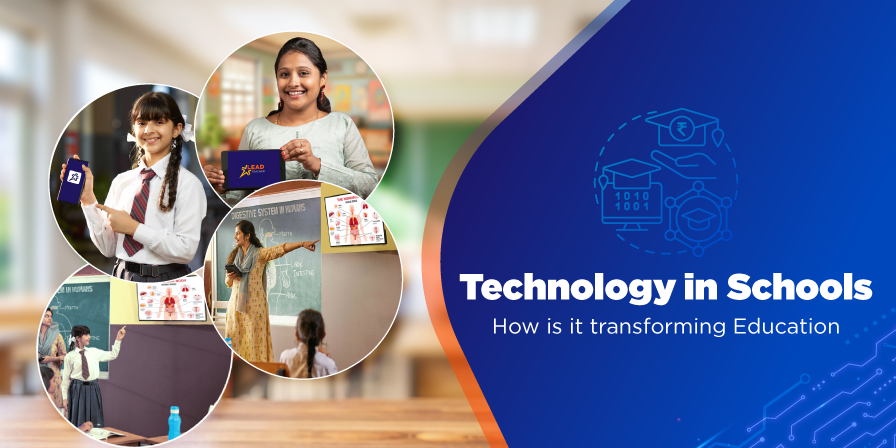What does a LEAD Powered School's classroom look like
The Role of Technology in School Education: How It is Transforming Education

The Role of Technology in School Education: How It is Transforming Education
Last Updated On: 28/01/2025
Bazla Kausar
School Owner
Understanding the Role of Technology in Education
Technology is changing the way we learn and teach. In today’s fast-paced world, where everything is digital, education’s only natural to follow suit. Technology in education isn’t just about using computers; it’s about enhancing how students understand and engage with what they learn. It makes learning more interactive and tailored to each student’s needs.
Integrating technology into classrooms is crucial because it prepares students for a future where digital skills are a must. It opens doors to new ways of learning, like virtual classrooms and interactive lessons, which keep students more engaged.
More than just a trend, technology in education is a powerful tool that helps bridge gaps, making learning more accessible and effective for all.
In this article

Why technology should be used in schools

Key Benefits of Using Technology in Education

Various tools to implement pertinent technologies in schools

Challenges in Implementing Technology in Schools

LEAD Group’s technology solutions for schools
Why the Use of Technology in Schools is Essential
- Accelerated Learning: Integrated learning systems accelerate the learning process of the students. Technology for schools incorporates the use of a unique approach to in-class activities using multimedia content and this develops a learning eagerness among the students.
- Personalised Learning: Through the means of technology for schools, teachers can create, and modify the curriculum as per students’ needs and preferences. In many integrated systems, students can also rearrange their courses as per their own routine. It allows access to education at any time.
- Increased Collaboration: With the use of smart boards in the classroom, communication between teachers and students increases. Teachers can engage students as they work together to solve a problem. Technology for schools enhances one-to-one interaction between students and teachers even in a classroom of high student strength.
NEP 2020 and the Integration of Technology in Education
The NEP 2020 strongly advocates for integrating technology into education to make learning more inclusive and effective. It introduces several initiatives to promote the use of digital tools in schools:
- Emphasis on Digital Infrastructure: NEP 2020 underlines the need for schools to build and upgrade their digital infrastructure. This is crucial to support technology-driven learning and make education more accessible.
- National Educational Technology Forum (NETF): The policy proposes setting up NETF to encourage the exchange of ideas, resources, and best practices on using technology in education, helping schools and educators stay updated.
- Promoting Online and Digital Education: NEP 2020 encourages the adoption of online and blended learning models. This approach aims to improve access to quality education, especially in remote and underserved areas.
- Teacher Training on Digital Tools: NEP 2020 stresses the importance of training teachers to effectively use digital tools in classrooms. This ensures they can provide a more interactive and engaging learning experience.
- Assessment and Evaluation through Technology: The policy advocates for using technology to enhance assessment and evaluation processes, making them more efficient, transparent, and focused on individual progress.
Key Benefits of Use of Technology in Education
Integrating technology in education offers numerous advantages that enhance the learning experience. From creating personalised learning paths to providing access to a wealth of resources, technology is transforming how students learn and interact with knowledge.
1. Personalised Learning Paths
Technology allows for customised learning experiences tailored to each student’s pace and style. With the help of digital tools, teachers can monitor student progress in real-time and adjust lessons to meet individual needs.
This personalised approach not only helps students overcome challenges but also fosters a love for learning as they explore subjects that interest them at their own pace.
2. Learning Beyond the Classroom
Technology has expanded the boundaries of the traditional classroom. Students can now engage in learning activities outside of school hours, whether it’s through online assignments, virtual field trips, or interactive lessons.
This flexibility encourages continuous learning and allows students to revisit challenging topics or explore new areas of interest, all from the comfort of their home.
3. Fosters creativity and problem-solving skills
Interactive technologies such as educational apps, coding platforms, and digital art tools provide students with opportunities to express their creativity and develop problem-solving skills.
By experimenting with these tools, students learn to think critically, approach problems from different angles, and come up with innovative solutions. This hands-on experience is invaluable in developing the creative mindset needed in today’s world.
4. Increased Access to Learning Resources
One of the biggest advantages of technology in education is the vast array of resources available to students. From online libraries and educational websites to virtual labs and e-books, technology puts a world of knowledge at students’ fingertips.
This access not only enhances their understanding of subjects but also encourages self-directed learning, allowing them to dive deeper into topics that captivate their interest.
5. Prepares Students for the Future
As the world becomes increasingly digital, it’s essential that students are prepared for the demands of the future job market. Integrating technology into education helps students develop the digital literacy and technical skills needed in virtually every career path.
Moreover, it fosters adaptability and resilience, ensuring students are ready to navigate and thrive in a rapidly changing world.
6. Supporting Inclusive Education
Technology plays a crucial role in creating an inclusive educational environment. Assistive technologies like speech-to-text software, screen readers, and adaptive learning platforms enable differently-abled students to access education in ways that were previously unimaginable.
These tools help bridge the gap, ensuring that all students, regardless of their abilities, have the opportunity to learn and succeed.
Never miss a story
Stay updated with the latest news and articles related to school education
GIVE YOUR SCHOOL THE LEAD ADVANTAGE
Various Tools for Implementing Technology in Schools
- SmartBoard: A smart board is a large whiteboard-sized touch screen display that acts like a computer and works with the help of software. The teacher can write on the display with the help of a digital pen usually called a stylus.Most smart boards come with a built-in projector for enhancing the presentation area. The smartboard is a technology for schools that can be used for all levels of education.
- Projector: A projector is an optical device used to project images and videos on projection screens or surfaces. This device that is an important part of technology for schools, is majorly complemented by smart boards in the classrooms. It makes note-making easier for students as even the student in the last row can clearly see the content.Using a projector, teachers don’t have to be bound with whiteboards and markers for the presentation of information. Instead, they can incorporate short films, slides, and images to make learning easy and interesting for students.
- Integrated Learning System: An integrated learning system is a set of hardware and software systems used to deliver educational content and manage every aspect of educational institutions. Most providers of technology for schools, provide some form of supervisory and assessment tools.Integrated learning systems offer seamless integration of all school functions and allow easy access through a simple app that can be installed on a mobile phone.
- Learning Management System (LMS): An LMS is a digital platform that manages, delivers, and tracks educational courses and content. It allows teachers to create and organise lessons, quizzes, and assignments in one place.It provides easy access to learning materials, progress tracking, and a structured learning path, making the education process more organised and efficient.
- ERP Software: ERP (Enterprise Resource Planning) software helps in managing the administrative tasks of a school, such as admissions, attendance, fee collection, and examination management.
By streamlining these processes, ERP software reduces manual errors and frees up time for educators to focus more on teaching and less on paperwork. - Digital Textbooks: Digital textbooks are electronic versions of traditional textbooks, accessible on computers, tablets, and e-readers. They are interactive and often include multimedia elements like videos, animations, and quizzes to enhance understanding.
Digital textbooks also reduce the need for heavy physical books, making them a convenient and eco-friendly option for schools.
New technology creates new opportunities in every sphere of life. Implementing technology for schools is essentially an example of such an opportunity. The use of technology incorporates rapid learning, promoting collaboration between students and teachers. Tools that are a part of technology for schools, like smart boards, smart tables, and projectors enhance the learning and teaching experience.
The use of an integrated learning system ensures a better-structured curriculum. Schools must understand that with a changing environment they need to change their traditional approach to teaching. The present post-pandemic time is the best opportunity for schools to upgrade into integrated learning systems.
Challenges in the Use of Technology in School Education
While technology brings numerous benefits to education, implementing it effectively in schools comes with its own set of challenges. Here are some key obstacles that schools often face:
Lack of Technical Expertise
Many teachers and staff have limited knowledge of using advanced technological tools, which can hinder the effective integration of technology in classrooms. Without proper training, educators may struggle to utilise these tools to their full potential.
Moreover, there is often a lack of comprehensive training programs to bridge this technology gap, leaving educators feeling overwhelmed and unsupported.
Data Privacy and Security Concerns
The increased use of cloud-based solutions in schools raises concerns about data privacy and security. There is a growing risk of cyberattacks and data breaches, which can compromise sensitive student information.
Additionally, schools may face challenges in complying with data protection laws and ensuring that student privacy is maintained at all times.
Teacher Training and Support
For technology to be effectively integrated, teachers need continuous professional development to stay updated on the latest tools and methods. Unfortunately, there is often a lack of sufficient technical support to help teachers during the implementation phase, leading to frustration and underutilisation of digital resources.
Equity and Accessibility Issues
Technology can widen the educational gap if not all students have equal access to digital tools or the internet at home. Special needs students may also require additional adaptive tools that are sometimes overlooked, limiting their ability to fully participate in tech-driven learning.
Integration with Existing Curriculum
Integrating technology into a traditional curriculum can be challenging. Schools must find a way to align tech tools with existing learning objectives without diluting content. This requires careful planning and a balanced approach to ensure that technology enhances rather than disrupts the learning experience.
LEAD Group’s technology solutions for schools
- LEAD Group offers state-of-the-art digital platforms that revolutionise the learning environment in schools. With its robust Learning Management System (LMS), LEAD simplifies lesson delivery, student assessment, and progress tracking, ensuring a streamlined digital learning experience.
- Schools also benefit from interactive tools like the LEAD Teacher App, which provides AI-powered assessment builders, digital books integrated with lesson plans. These tools help teachers address learning gaps and enhance classroom engagement.
- To support educators, LEAD Group provides comprehensive training programs and ongoing support, ensuring teachers are skilled in using digital tools and integrating technology seamlessly into their teaching practices. Additionally, LEAD’s school ERP software helps streamline administrative tasks, making school management more efficient.
- With smart classroom solutions and implementation assistance, LEAD Group ensures a smooth transition to a digitally enhanced learning environment, boosting both teaching efficiency and student outcomes.
- LEAD Techbook is another innovative solution, combining augmented reality (AR) and AI-driven personalised learning to create an interactive and engaging learning experience. The Techbook is designed to cater to different learning levels, offering personalised instruction in subjects like Math, Science, and English.
By bringing concepts to life through 3D visualisations and real-time feedback, the Techbook transforms traditional textbook learning, making complex subjects easier to understand and more engaging for students.
Conclusion: The Role of Technology in Transforming Education
Technology for schools is an integral part of making schools future-ready. By leveraging the right technology for schools, you can also make your school ready for the technology recommendations provided by NEP 2020. To know how LEAD Group can help you in the same, call us on +91 86828 33333 for a free demo.




